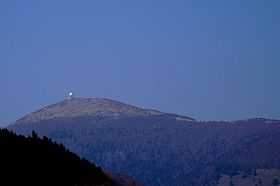Grand Ballon
| Grand Ballon | |
|---|---|
 The Grand Ballon from the South | |
| Elevation | 1,424 m (4,672 ft) |
| Prominence | 1,072 m (3,517 ft) |
| Translation | Big balloon (French) |
| Location | |
 Grand Ballon | |
| Location | Haut-Rhin, Alsace, France |
| Range | Vosges Mountains |
| Coordinates | 47°54′03″N 7°05′53″E / 47.90083°N 7.09806°ECoordinates: 47°54′03″N 7°05′53″E / 47.90083°N 7.09806°E |
| Climbing | |
| First ascent | unknown |
Le Grand Ballon (German: Großer Belchen; translates as "great round-topped mountain", literally big balloon ) is the apex of the Vosges Mountains, located 25 kilometres northwest of Mulhouse, France. It is also the highest point of the Alsace French region.[1]
Some still call it Ballon de Guebwiller, after the name of the closest city, Guebwiller, located 8 km to the east. It is 1423.7 metres high, according to the Institut Géographique National (IGN).
The well known Route des Crêtes (French for road of the peaks) circumvents the mountain top around east, crossing a mountain pass at an altitude of 1343 m, between Le Markstein winter sports station and Hartmannswillerkopf rocky spur.
Climate
Along with the Hohneck the summit of the Grand Ballon is the coldest and windiest point in Alsace. A record low of -30.2°C was recorded 10 February 1956, a record high of 29°C was recorded 13 August 2003. The difference between the Grand Ballon and the neighboring plain (Mulhouse area) usually ranges from 7°C to 10°C and is higher in summertime.
Winter snow cover is usually more than 1.50 metres (4 ft 11 in) above 1,350 metres (4,430 ft) of altitude. The highest snow accumulation ever recorded was 3.70 metres (12.1 ft) 7 March 2006; in 1969 and 1970 the snow cover was above 3 metres (9.8 ft).
Tour de France
The road over the pass to the north of the mountain is occasionally used in the Tour de France, the first crossing being in 1969. It is the only Hors categorie (beyond categorization) climb in northern France.
References
- ↑ France Region High Points, web-page on www.peakbagger.com
External links
| Wikimedia Commons has media related to Grand Ballon. |